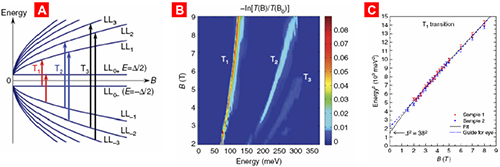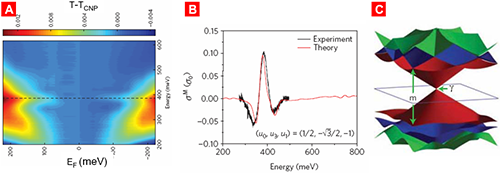 |
Figure 1: Graphene Molar Superlattice Structure (A) and Schematic (B)

Figure 2: (A) Schematic diagram of the selection rules for transitions between different Landau levels. (B) Experimentally measured infrared transition spectra corresponding to the three transitions T1T2T3. (C) The simulation of T1 transition data yields Δ=~38 meV.

Figure 3: (A) Microscopic infrared transmission spectrum of a graphene mole superlattice. An abnormal optical absorption peak occurs at Fermi energy at 380 meV. The potential component parameters (B) obtained from the experimental results are fitted with the three potential components and the graphene molar superlattice band diagrams are back-calculated using these three parameters.
Recently, the Institute of Physics, Chinese Academy of Sciences/National Laboratory for Condensed Matter Physics, Beijing University of Science and Technology (Nanjing) has published the "Nano-Material," "Nature, Nanotechnology," "Nature, Physics," and "Nature-Communications." A series of research results. For graphene/boron nitride heterostructures, they systematically studied the MoL superlattices modulated by boron nitride and related physical phenomena, providing new ideas for graphene energy band and electronic properties regulation.
The graphene/boron nitride heterostructure has attracted extensive research interest in the field of international two-dimensional material and physics research in the past two years. Graphene and hexagonal boron nitride have similar atomic structures and both have two sublattices; the difference is that the former two sublattices are all composed of carbon atoms, and the latter two sublattices are respectively composed of nitrogen and boron atoms. constitute. In addition, there is a lattice mismatch of approximately 1.7% between the two, and this lattice mismatch leads to the appearance of Molar Patterns, and the period of the Molar Pattern is closely related to the relative lattice angles of the two.
The maximum molar pattern period, about 15 nm, occurs when the relative lattice angle is zero. The Molar pattern can be seen as a two-dimensional periodic potential of graphene on a hexagonal boron nitride substrate, ie, a two-dimensional superlattice. The superlattice changes the energy band of the intrinsic graphene and produces a self-similar superlattice lattice with unique transport properties. Theoretically, it is predicted that due to the different chemical potentials of the two sub-lattices on the boron nitride substrate, the sub-lattice symmetry of the graphene is locally broken, resulting in the appearance of the graphene band gap. However, this speculation lacks relevant experimental evidence; in addition, how the boron nitride substrate interacts with the two sub-lattices of graphene also lacks in-depth experimental exploration.
In order to obtain graphene/boron nitride heterostructures, Institute of Physics, Nanophysics and Devices Lab, Zhang Guangyu, Shi Dongxia, Yang Rong, Research Associate, Ph.D. Yang Wei, Shi Zhiwen, Lu Xiaobo, etc. developed a vapor phase epitaxy technique. For the first time, a large-area single-crystal graphene was epitaxially grown on a hexagonal boron nitride substrate, so that the lattice relative rotation angle between graphene and boron nitride was zero. In transport measurements, they observed superlattice lattice bands and the superlattice Langdon energy levels formed under magnetic fields.
Using this high-quality graphene/boron nitride heterostructure sample, they collaborated with Professor Wang Feng and Dr. Shi Zhiwen of the University of California, Berkeley, and Professors Li Zhiqiang and Dr. Zhiguo Zhi of the National Strong Magnetic Field Laboratory in Florida, USA. The intrinsic band gaps of this kind of molar superlattice and the control of the electron gallium spin in the graphene mol superlattice by the boron nitride substrate were studied by means of infrared spectroscopy.
They first applied a vertical magnetic field to the graphene Molar superlattice sample and measured the transitions between the Landau energy levels at different magnetic fields. It is found that the curve of the energy (E) with the magnetic field (B) accords with the relationship, indicating that the quasi-particles in the graphene superlattice are mass Dirac fermions, and there is a band gap at the intrinsic Dirac point. The experimentally measured band gap is Δ=~38meV (~440K). It is also found that the effective Fermi velocity at the Landau energy level transition decreases with the increase of the magnetic field. This phenomenon cannot be explained by the theory of single particle approximation, indicating that the multibody interaction plays an important role in this system. . Based on this, they used the synchrotron radiation source of Lawrence Berkeley National Laboratory to observe an optical absorption peak in the graphene mole superlattice that matches the superlattice energy.
This optical absorption peak corresponds to the electronic transition near the superlattice Dirac point. Further theoretical analysis shows that the periodic potential of graphene from the boron nitride substrate in the superlattice cannot be described by a simple electrostatic potential scalar function, but rather expressed by a 2×2 matrix. This tensor cycle potential contains three components with specific physical meanings (μ0, μ3, μ1) that describe different types of periodic potentials: used to characterize the potential components symmetrical to the two sublattices; used to describe two The potential component of the lattice is antisymmetric; and the potential component that will reverse the contribution from the two sublattices in the electron wave function is called the èµ-spin hybridization potential.
By comparing the theory with the experiment, they found that the helium-spin hybrid potential dominates these three potential components. Further experiments show that the influence of the periodic potential from the substrate on the electronic state transitions in graphene will decrease with increasing Fermi level in graphene. A reasonable explanation is that the free electrons in graphene are partially shielded from The base cycle potential. These results have deepened the understanding of the graphene èµ spin structure, and pointed out a way to regulate the graphene èµ spin through the superlattice.
The series of work was supported by the projects of young scientists of the Ministry of Science and Technology's major scientific research project (nanometer project), the National Natural Science Foundation of China's major research project (basic research on nano-manufacturing), the Outstanding Youth Fund, and the Class B Pilot of the Chinese Academy of Sciences.
Function introduction
★ According to the serial port or industrial Ethernet interface data, read the corresponding text, picture, video, and display the corresponding content.
★ Modify the display text, picture, video function through the serial port or industrial Ethernet interface.
★ Set parameters.
★ The function of setting the display parameters through the serial port or industrial Ethernet interface; including: grayscale,color, brightness, display speed, screen split and merge, etc.
We providing Transparent Led Glass Display,Transparent LED Display Led Screen,Transparent Led Glass Display Outdoor,Transparent Led Glass Display Indoor.
Transparent Led Glass Display,Transparent LED Display Led Screen,Transparent Led Glass Display Outdoor,Transparent Led Glass Display Indoor
Shenzhen Filmbase Technology Co., Ltd. , https://www.globalfilmbase.com